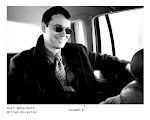For those who have only read Pale Fire
from the first page to the last, I'd very much
suggest trying to read following the instructions
Kinbote leaves in the text. Of course it gives a
sense of Kinbote's obsessive mind, brooding
over slights which can never be redressed, lost
paradises and missed opportunities - as well
as a certain playfulness which can not be
dismissed - but although Kinbote is the one
giving the instructions, progressing through
the work using his instructions, e.g., see note to
line 919, as a road map also defeats him in the end.
Kinbote makes a point that the commentator
gets the last word, but I defy any two readers
(or even any one re-reader twice )to take the exact
same journey through the notes. It's too
complicated. There are too many ambiguities.
No two readings will always return to the
same place after all the departures.
Although Nabokov believed fervently in
rereading books, once you start following
the notes, you'll never read the exact same
Pale Fire twice. (Support me here,
Heraclitus!) Inevitably the final word will
be shared - between Nabokov and the
sympathetic reader.
Friday, December 10, 2010
Reading Pale Fire: Note by Note
Labels:
Charles Kinbote,
Heraclitus,
John Shade,
Pale Fire,
Vladmir Nabokov
Subscribe to:
Post Comments (Atom)

No comments:
Post a Comment